GMC tuning
GMC Sierra 1990 Tuning: Bringing Modern Power to Your Classic Truck
Achieve a powerful transformation for your 1990 GMC Sierra with modern upgrades that enhance performance—discover how to unleash its true potential.

Tuning your 1990 GMC Sierra is an exciting way to blend classic style with modern power. Start by upgrading the V8 engine with performance enhancements like a high-flow fuel pump and aftermarket fuel injectors. Don't forget to replace the spark plugs and upgrade the air intake for better airflow. Consider installing long tube headers to improve exhaust flow, and a modern camshaft for increased torque. You can also enhance your truck's handling with adjustable suspension kits. By making these upgrades, you'll elevate not just performance but also driving enjoyment, and there's even more to explore in maximizing your Sierra's potential.
Key Takeaways
- Upgrade to a performance fuel injection system for improved air-fuel mixture and engine efficiency.
- Install a modern camshaft to enhance low-speed torque and overall horsepower.
- Implement high-flow exhaust components like headers and catalytic converters for better exhaust flow.
- Utilize a turbocharger or supercharger to significantly boost horsepower and torque in the engine.
- Regularly perform maintenance and tune-ups to ensure optimal performance and reliability of enhancements.
Engine Overview and Specifications
The 1990 GMC Sierra OBS pickup offers a range of engine options that cater to diverse performance needs, from the efficient 4.3L V6 to the powerful 7.4L V8. These configurations highlight the truck's robust capabilities, making it a popular choice among enthusiasts.
The Sierra originally utilized a Throttle Body Injection (TBI) system, which was known for its simplicity and efficiency. This system helped optimize fuel delivery, providing decent mileage for the era while ensuring reliable performance.
If you're looking to enhance your Sierra's capabilities, consider performance upgrades that can maximize the engine's potential. Upgrading components like the throttle body can improve airflow, resulting in better combustion and enhanced horsepower.
Simple modifications, such as aftermarket fuel injectors or an improved induction system, can greatly boost your truck's efficiency and responsiveness.
Performance Enhancements and Modifications
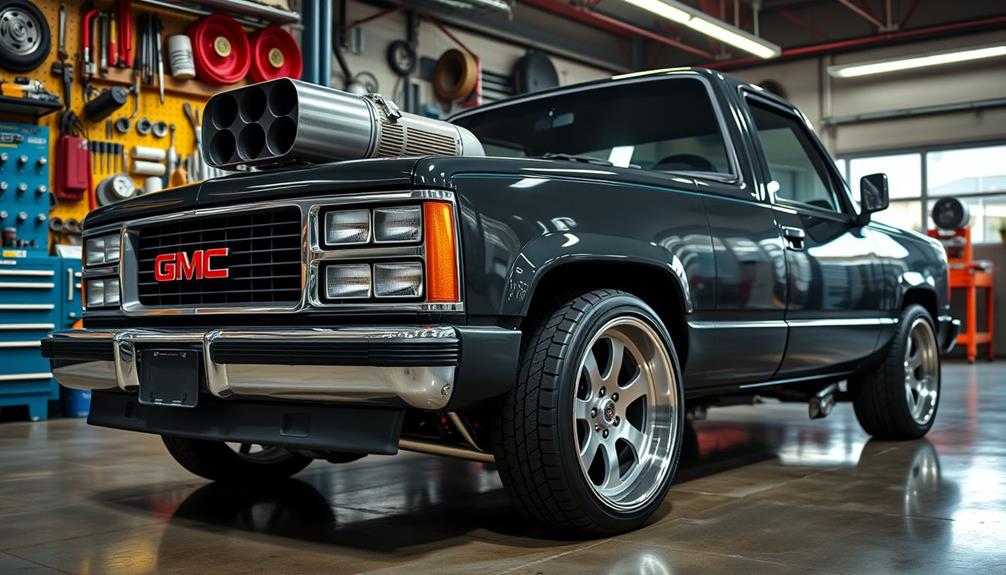
To boost your 1990 GMC Sierra's performance, you'll want to focus on essential tune-up steps like upgrading the air intake and exhaust system.
Effective fuel upgrades, such as installing a larger fuel pump and adjustable fuel pressure regulators, can make a noticeable difference in engine responsiveness.
With these modifications, your truck won't only run better but also deliver more power on the road.
Essential Tune-Up Steps
When you're looking to maximize the performance of your 1990 GMC Sierra, an all-encompassing tune-up is crucial for guaranteeing everything runs smoothly.
Start with a complete tune-up by replacing the spark plugs, wires, distributor cap, and rotor. Don't forget to clean the throttle body injection (TBI) unit to enhance ignition and fuel delivery.
Next, upgrade your air intake system by swapping the stock snorkel for an open air element or cold air intake (CAI). This modification boosts airflow and improves throttle response, giving you that extra kick when you hit the gas.
Consider installing a larger fuel pump, like the Walbro 255lph, alongside an adjustable fuel pressure regulator. This will support the increased power demands and maintain peak fuel pressure.
For even better fuel economy, modify the TBI by removing the injector ridge, shaving the throttle shafts, and adding an injector pod spacer, potentially yielding a 5% improvement in airflow.
Lastly, upgrade your exhaust system with long tube headers and a high-flow catalytic converter for significant improvements in exhaust flow and overall engine performance.
These essential steps will guarantee your Sierra performs at its best.
Effective Fuel Upgrades
Upgrading the fuel system in your 1990 GMC Sierra can greatly enhance performance, especially after completing those initial tune-up steps. To maximize your engine's potential, consider several effective fuel upgrades that focus on fuel injection and air intake.
Start with a high-flow fuel pump, like the Walbro 255lph, to support increased power from your modifications. Pair this with an adjustable fuel pressure regulator (AFPR) for ideal fuel delivery. Replacing the stock injectors with marine versions rated at 24#/hr will improve fuel flow, especially when combined with other engine upgrades.
Implementing a multi-port fuel injection (MPFI) system, such as the Holley Stealth Ram, will enhance both airflow and fuel atomization, which leads to better throttle response and power output.
Here's a summary of these upgrades:
| Upgrade Type | Benefits |
|---|---|
| High Flow Fuel Pump | Supports power increases |
| Adjustable Fuel Pressure Regulator | Optimizes fuel delivery |
| Marine Injectors (24#/hr) | Enhances fuel delivery |
With these effective fuel upgrades, your GMC Sierra will not only run more efficiently but will also release a new level of performance.
Fuel System Upgrades

The fuel system in your 1990 GMC Sierra plays an essential role in maximizing performance, especially when you've swapped in a powerful LS 5.3L engine.
Upgrading to a high-flow fuel pump, like the Walbro 255lph, is imperative for supporting increased horsepower and ensuring ideal fuel delivery. You'll want to install an adjustable fuel pressure regulator (AFPR) to fine-tune fuel pressure, which is fundamental for performance, particularly when you add modifications like a new intake.
To further enhance fuel delivery, consider using Vortec engine injectors rated at 24#/hr, especially if you're pushing beyond stock performance levels.
Replacing the stock throttle body with a larger aftermarket option can considerably improve airflow into the engine, directly impacting horsepower and throttle response.
Additionally, switching to a multi-port fuel injection (MPFI) system, such as the Holley Stealth Ram, can greatly enhance fuel atomization, leading to better overall engine efficiency compared to the original TBI configuration.
These fuel system upgrades won't only elevate your Sierra's performance but also deliver the reliability you need on the road.
Camshaft and Exhaust Improvements

Upgrading your camshaft can transform your GMC Sierra's performance by boosting low-speed torque and overall horsepower.
Pairing this with long tube headers and a high-flow catalytic converter will greatly improve exhaust flow, making your engine more efficient.
Together, these enhancements create a powerful combination that maximizes your truck's potential on the road.
Camshaft Design Benefits
If you're looking to boost the performance of your 1990 GMC Sierra, exploring camshaft design benefits is a smart move. Upgrading to a modern camshaft can greatly enhance low-speed torque and overall horsepower, especially with your stock engine setup.
By choosing camshaft profiles with lifts greater than 0.400, you can alleviate the limitations of stock camshafts, improving airflow and combustion efficiency.
Consider the Comp Cams XFI series camshafts, which work well with beehive springs. This compatibility allows for higher lift potential and better performance without compromising reliability. Not only will a performance-oriented camshaft enhance your truck's power, but it'll also give your engine a more aggressive sound, offering an audible cue that something's changed under the hood.
When selecting a camshaft for tuning, keep in mind your entire engine setup. A well-matched camshaft optimizes power delivery across the RPM range, making your GMC Sierra feel responsive and alive.
Pair this upgrade with performance chips for even greater gains, and you'll truly enjoy the transformation of your classic truck into a modern powerhouse.
Exhaust System Upgrades
Enhancing your 1990 GMC Sierra's performance goes hand in hand with upgrading the exhaust system. One of the best moves you can make is installing long tube headers. These headers improve exhaust flow and reduce back pressure compared to stock manifolds, resulting in a noticeable increase in horsepower and torque.
To further boost efficiency, consider high-flow catalytic converters, which replace restrictive stock units and amplify performance gains.
Pairing these upgrades with a camshaft featuring a lift over 0.400 can greatly enhance low-speed torque and overall horsepower. Options like Comp Cams' XFI series seamlessly fit with aftermarket components, optimizing your setup.
Additionally, a performance exhaust system is essential; larger diameter pipes and a free-flowing muffler not only enhance the sound but also minimize exhaust back pressure, enhancing engine performance even more.
Don't overlook roller rockers when upgrading your camshaft. They reduce friction and improve airflow, maximizing the benefits of your exhaust system upgrades.
Performance Enhancements Overview
A well-chosen camshaft and exhaust system can dramatically elevate your 1990 GMC Sierra's performance. Upgrading the camshaft is a game-changer, greatly enhancing low-speed torque and horsepower. Modern designs, like those from Comp Cams, offer lift potential over 0.400, ensuring you get the most out of your engine without sacrificing reliability.
Pairing this upgrade with roller rockers can further reduce frictional losses, maximizing overall efficiency.
Transitioning to your exhaust system, installing long tube headers is vital. They improve exhaust flow, which is important since stock systems can be quite restrictive. Additionally, replacing high-flow catalytic converters not only boosts exhaust efficiency but also reduces backpressure, allowing your engine to breathe easier.
Don't forget to take into account performance chips as part of your tuning strategy. They can optimize your engine's parameters to work harmoniously with these enhancements.
While upgrading, keep an eye on maintenance items, ensuring your truck runs smoothly and efficiently. With these camshaft and exhaust improvements, your GMC Sierra won't only drive better but also feel like a completely different machine on the road.
Maintenance and Tune-Up Essentials
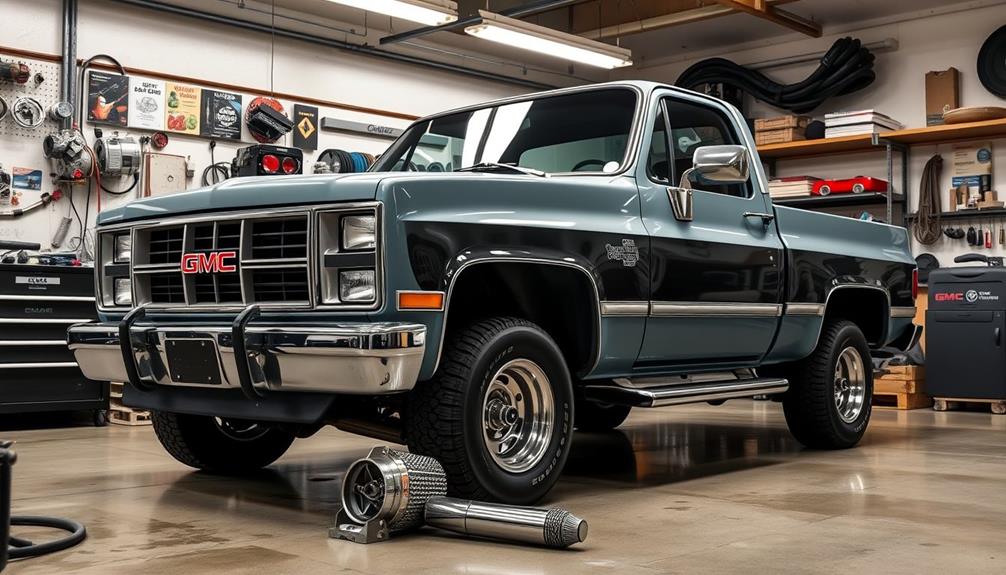
Maintaining your 1990 GMC Sierra is essential for keeping it running at its best. A solid tune-up won't only enhance performance but also prolong the life of your classic truck.
Focus on these important maintenance items to keep everything in check:
- Replace key components: Swap out the air filter, distributor cap, rotor, and spark plugs. These are critical for peak engine performance.
- Regular inspections: Check your fuel filter, O2 sensors (every 65,000-80,000 miles), and PVC valve. Keeping these in good condition helps prevent issues and maintain efficiency.
- Clean and test: Don't forget to clean the Idle Air Control (IAC) valve for better idle quality. Testing the Throttle Position Sensor (TPS) with a voltmeter guarantees it's sending the right signals.
Incorporating performance chips can also enhance your Sierra's efficiency, but it's important to keep up with these maintenance items first.
Regularly checking coolant levels and changing your oil and filter will help you avoid costly repairs.
Modern Performance and Handling Upgrades

Upgrading your 1990 GMC Sierra with modern performance and handling enhancements can transform your driving experience.
Start by installing a performance fuel injection system, which precisely controls the air-fuel mixture, boosting both fuel efficiency and power output. If you've swapped in an LS 5.3L engine, consider adding a turbocharger or supercharger to considerably enhance horsepower and torque.
For improved handling, adjustable coilover suspension kits allow you to customize the ride height and achieve better stability. When paired with performance tires and upgraded sway bars, you'll notice a reduction in body roll, leading to improved grip and cornering dynamics.
This combination guarantees your truck performs well during both daily driving and spirited turns.
Don't overlook the benefits of a performance chip or tuner. These devices optimize engine parameters, enhancing throttle response and fuel economy to meet your specific performance goals.
With these upgrades, your GMC Sierra won't just look classic; it'll deliver modern performance that makes every drive enjoyable. Embrace these enhancements to truly bring your classic truck into the present day.
Safety and Braking Enhancements

While enhancing your 1990 GMC Sierra's performance, don't overlook the critical importance of safety and braking upgrades. A solid braking system is essential for your truck's overall handling and safety, especially when adding performance chips for increased power.
Here are three key enhancements to keep in mind:
- Upgrade to Disc Brakes: Switching from drum to disc brakes greatly improves your stopping power. It reduces the risk of brake fade, especially during high-speed stops.
- Install Anti-Lock Braking Systems (ABS): ABS can enhance your vehicle control by preventing wheel lock-up during sudden braking. Keep in mind that retrofitting may require extensive modifications.
- Choose Premium Brake Components: Incorporate larger diameter rotors and high-performance calipers for better heat dissipation and improved pedal feel. Using premium brake pads designed for performance applications will also reduce stopping distances.
Lastly, don't forget about seat belts.
Regularly inspect and replace brake components, including hoses and lines, to maintain peak braking performance and guarantee your safety while enjoying the ride.
Interior Comfort Upgrades

Transforming your 1990 GMC Sierra's interior can turn your truck into a more enjoyable and comfortable driving environment.
Start by upgrading to leather seats; they not only enhance your truck's aesthetic appeal but also provide superior comfort and longevity compared to standard fabric seats. You'll feel the difference during long drives.
Next, consider enhancing your audio experience. Replacing outdated speakers with a high-quality sound system will deliver good sound, improving audio clarity and bass response.
You'll find that your favorite music sounds even better as you cruise down the road.
Don't forget about climate control. Upgrading to a modern A/C system can greatly enhance cooling efficiency, ensuring you stay comfortable during hot summer days.
Installation costs typically range from $800 to over $1,700, but the investment is well worth it.
Tools and Equipment for Tuning
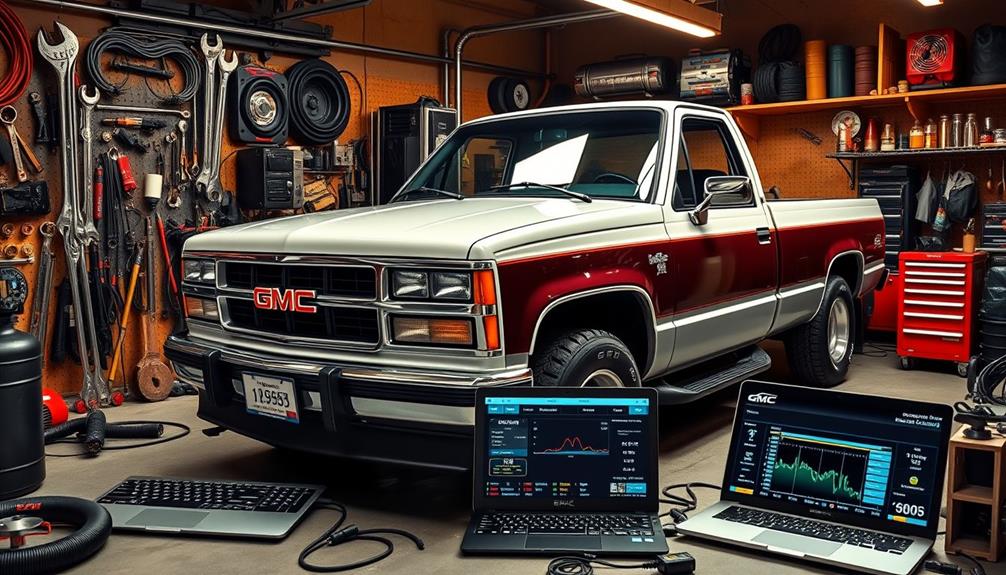
Effective tuning of your 1990 GMC Sierra requires the right tools and equipment to guarantee success and precision. With the proper setup, you'll be able to enhance performance by fine-tuning the amount of fuel and improving the overall efficiency of your ride.
Here's a quick list of essential tools you shouldn't overlook:
- Socket Set, Wrenches, and Screwdrivers: These basics help you facilitate engine modifications and repairs.
- OBD-II Scanner: This tool is vital for diagnosing performance issues and monitoring engine parameters after tuning, especially when using Jet Performance products.
- Multimeter: Essential for electrical testing, it helps diagnose problems in the ignition and fuel systems.
Additionally, don't forget about compression testers to assess engine health post-modifications. It confirms your cylinders are within acceptable pressure ranges, vital for effective tuning.
Finally, keep cleaning supplies like carb cleaner and microfiber cloths handy. They'll help maintain engine cleanliness during the tuning process, guaranteeing peak performance.
With these tools at your disposal, you're well-equipped to bring modern power to your classic GMC Sierra.
Truck History and Specifications

When you plunge into the history and specifications of the 1990 GMC Sierra, you'll discover a pickup that embodies durability and classic style. This truck, originally equipped with a robust V8 engine, showcases the engineering prowess of its era.
It features factory amenities like power windows, locks, tilt steering, and air conditioning, ensuring a comfortable driving experience.
With a clean auto check and five previous owners, the Sierra has a well-maintained history, boasting high auto check scores with no reported crashes or major issues. This reliability makes it a standout choice for vintage truck enthusiasts.
The exterior retains its original white color, while the blue interior adds a touch of sophistication. You might notice some aftermarket enhancements that improve performance and aesthetics, but the classic style remains intact.
This GMC Sierra not only captures the essence of its time but also serves as a canvas for modern tuning possibilities. Its blend of original features and potential upgrades makes it a timeless pickup that continues to impress both collectors and casual drivers alike.
Frequently Asked Questions
How Much Horsepower Does a 1990 GMC Sierra 5.7 Have?
A 1990 GMC Sierra with the 5.7L V8 engine produces around 230 horsepower at 4,600 RPM. If you're considering modifications, you can considerably boost that horsepower beyond stock levels with the right upgrades.
How Do I Get More Horsepower in My GMC Sierra?
To boost horsepower in your truck, consider upgrading the fuel pump, installing a larger throttle body, and adding a performance camshaft. Replacing the exhaust system and using a custom chip can also enhance performance considerably.
What Is the Best Engine for the GMC Sierra 1500?
When it comes to power, you can't go wrong with the LS series. The Gen 3 5.3L V8's efficiency and aftermarket support make it the best engine for your GMC Sierra 1500, hands down.
Do GMC Trucks Have Generators?
GMC trucks don't typically come with generators; they use alternators to power electrical systems. If you need extra power, consider installing an aftermarket generator or a high-output alternator to meet your demands.
Conclusion
By tuning your 1990 GMC Sierra, you're not just enhancing performance, but also breathing new life into a classic truck that's been a favorite for decades. Did you know that the Sierra's towing capacity has improved by over 30% with modern upgrades? With the right modifications, you can enjoy both power and reliability, making every drive a thrilling experience. So, get ready to hit the road with a truck that combines nostalgia and modern efficiency!
Sophia has a keen eye for automotive aesthetics and a passion for helping car owners express their personal style through their vehicles. With years of experience in designing custom body kits, spoilers, and carbon fiber parts, Sophia brings a wealth of knowledge to our appearance tuning section. Her articles and recommendations are perfect for anyone looking to make their car stand out on the road or at a show.
GMC tuning
GMC Acadia Intake Manifold Tuning Valve: Enhancing Power and Efficiency in Your SUV
Fuel your curiosity about the GMC Acadia’s Intake Manifold Tuning Valve and discover how it can transform your SUV’s performance and efficiency.
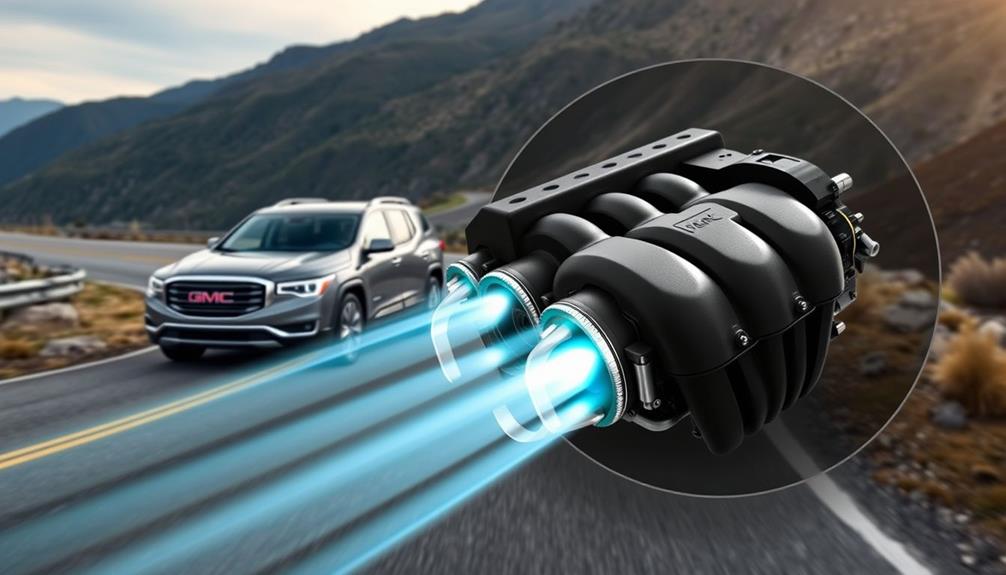
The GMC Acadia's Intake Manifold Tuning (IMT) valve greatly enhances your SUV's performance by optimizing airflow and adjusting intake runner length. This adjustment improves combustion efficiency and increases torque, giving you better acceleration and fuel efficiency. You'll notice up to a 10% improvement in fuel consumption under ideal conditions. If the valve malfunctions, you might experience power loss or increased fuel use, so regular maintenance is vital. Understanding its function and keeping it in check can maximize your driving experience. There's more to discover about the IMT valve's impact on your SUV's performance and efficiency as you explore further.
Key Takeaways
- The IMT valve optimizes engine performance by adjusting intake runner length for improved airflow and increased power output.
- Enhanced torque across various RPM ranges contributes to better acceleration and overall driving experience.
- Regular maintenance of the IMT valve reduces carbon buildup, ensuring efficient combustion and enhanced fuel economy.
- Common symptoms of IMT valve issues include power loss, increased fuel consumption, and engine vibrations, indicating the need for inspection.
- Repair costs for IMT valve issues typically range from $250 to $500, making regular maintenance a cost-effective solution.
Understanding the IMT Valve Function
The GMC Acadia's Intake Manifold Tuning (IMT) valve is vital for enhancing engine performance. This valve adjusts the length of the intake runners, which directly influences how air flows into the engine. By fine-tuning this airflow, the IMT valve boosts engine efficiency and increases power output.
Additionally, understanding common financial terms can help you make informed decisions when investing in vehicle upgrades or maintenance.
You'll notice that as the IMT valve alters the intake manifold configuration, it effectively improves torque across various RPM ranges. This means you can enjoy better overall vehicle performance, whether you're accelerating on the highway or maneuvering through city streets.
A well-functioning IMT valve can also contribute to improved fuel efficiency, which helps reduce your fuel consumption during daily drives.
Additionally, the IMT valve plays a significant role in emissions control. By ensuring an ideal air-fuel mixture, it assists your GMC Acadia in meeting regulatory standards for emissions, keeping your vehicle environmentally friendly.
However, if you experience malfunctions with the IMT valve, such as triggering diagnostic trouble codes like P2070, it's important to inspect or replace it promptly. This action will restore proper engine function and maintain the performance benefits that the IMT valve provides.
Benefits of Tuning Valve Optimization

Optimizing the Intake Manifold Tuning (IMT) valve can greatly boost your engine's performance.
By incorporating advanced technology, similar to what's found in the energy-efficient models, you'll notice enhanced fuel efficiency, reducing your fuel consumption while enjoying better acceleration.
Improved Engine Performance
Enhancing engine performance is a key benefit of the Intake Manifold Tuning (IMT) valve in your GMC Acadia. This component optimizes airflow into the engine, improving the air-fuel mixture for better combustion efficiency. As a result, you experience increased power and responsiveness, making your driving experience more enjoyable.
Additionally, investing in quality components, much like how Noble Gold offers a range of precious metal investment options, can greatly enhance your vehicle's performance.
The IMT valve adjusts the length of the intake runners based on RPM, maximizing torque across low and high ranges. This means smoother acceleration when you need it most. A properly functioning intake valve reduces engine load, which not only enhances performance but also decreases the likelihood of triggering the P2070 code, a signal of IMT issues.
Regular maintenance and cleaning of the IMT valve are essential. It helps prevent carbon buildup, ensuring your engine runs smoothly without misfires or vibrations.
With a well-tuned IMT valve, you can expect a quieter, more stable ride, enhancing overall driving comfort. By prioritizing the performance of your IMT valve, you'll enjoy a more powerful and efficient GMC Acadia, ready to handle any journey you begin.
Enhanced Fuel Efficiency
Improved engine performance directly correlates to enhanced fuel efficiency in your GMC Acadia. The Intake Manifold Tuning (IMT) valve plays an essential role in maximizing airflow, ensuring the right air-fuel mixture for various engine conditions.
By fine-tuning the runner length, the IMT valve effectively boosts combustion efficiency and can provide you with up to a 10% improvement in fuel consumption under ideal conditions. Additionally, vehicles equipped with advanced features, much like the best HEPA filter vacuums, can greatly enhance overall performance by maintaining a cleaner environment.
Here's how an optimized IMT valve benefits your SUV's fuel efficiency:
- Better Airflow: It adjusts airflow to match engine demands, maximizing efficiency across a wider RPM range.
- Reduced Carbon Buildup: A well-functioning valve minimizes deposits in the intake, promoting cleaner combustion and enhancing overall mileage.
- Consistent Performance: Regular maintenance of the IMT valve prevents performance drops, ensuring you enjoy sustained fuel efficiency throughout your vehicle's lifespan.
Common Symptoms of IMT Valve Issues

Common symptoms of Intake Manifold Tuning (IMT) valve issues often include a variety of noticeable performance problems. If your manifold tuning valve is stuck open, you might feel a significant drop in engine power during acceleration, leading to an overall sluggish driving experience. This can be particularly frustrating, especially if you frequently drive in areas where quick acceleration is necessary.
You may also notice that your Check Engine Light has activated, which often comes with the P2070 diagnostic trouble code, signaling a malfunction in the valve. For instance, ensuring you select the right maintenance products can help mitigate some of these performance issues, as proper care is essential for your vehicle's efficiency importance of selecting the right cold medication.
In addition to these signs, you could experience increased fuel consumption. This happens when the IMT valve disrupts the ideal air-fuel mixture, causing your engine to work harder and consume more fuel than necessary.
Unusual engine noises or vibrations are also red flags that your IMT valve may not be functioning properly.
Troubleshooting IMT Valve Problems

Troubleshooting IMT valve problems starts with a thorough inspection of the wiring and connectors. Look for any signs of damage, corrosion, or loose connections that could affect the valve's operation.
Once you've checked the wiring, it's also important to evaluate how appliance maintenance plans can help in extending the longevity of your vehicle's components.
Follow these steps to further diagnose the issue:
- Manually check the valve's mobility: Gently attempt to move the valve to see if it's stuck open or closed.
- Clean the valve: If you notice carbon buildup, clean it carefully to guarantee it can function properly.
- Use a scanner: After performing these checks, clear any error codes, especially if the check engine light was triggered.
If the valve remains immobile during your inspection, you may need to replace it to restore your GMC Acadia's performance and efficiency.
Remember to monitor for any recurring error codes after troubleshooting. Identifying the root cause of IMT valve issues can prevent further engine performance degradation and improve overall fuel efficiency, so stay vigilant and proactive in your troubleshooting efforts.
Replacement Options and Considerations
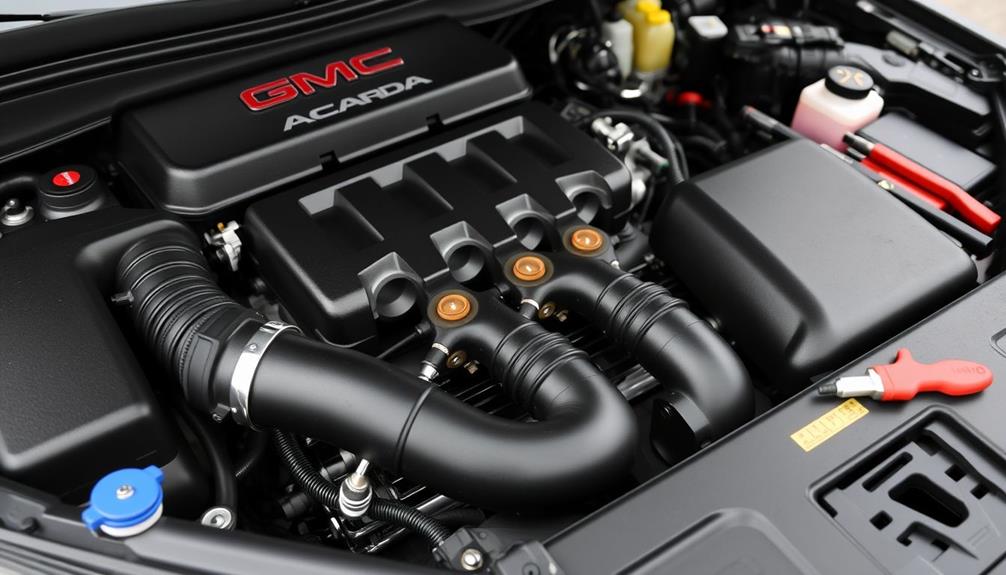
When it's time to replace the Intake Manifold Tuning (IMT) valve in your GMC Acadia, weighing your options wisely can save you time and money.
You'll need to take into account both OEM and aftermarket replacement options. OEM parts usually offer a reliable fit and are made to the manufacturer's specifications, while aftermarket parts may be cheaper but can vary in quality.
Regular maintenance, such as fuel injection cleaning, can help prevent issues like carbon buildup that affect the IMT valve's performance.
The average cost for IMT valve replacement ranges from $250 to $500, including labor, so it's smart to check if the repair is covered under warranty. If you discover the valve is stuck open due to carbon buildup, cleaning the valve first might be a cost-effective solution before committing to a full replacement.
Proper installation is essential, so always follow manufacturer guidelines and use the correct torque specifications to guarantee peak performance.
Additionally, consulting with automotive professionals or checking GMC Acadia forums can provide valuable insights on reliable parts suppliers and experienced mechanics.
Community Experiences and Insights
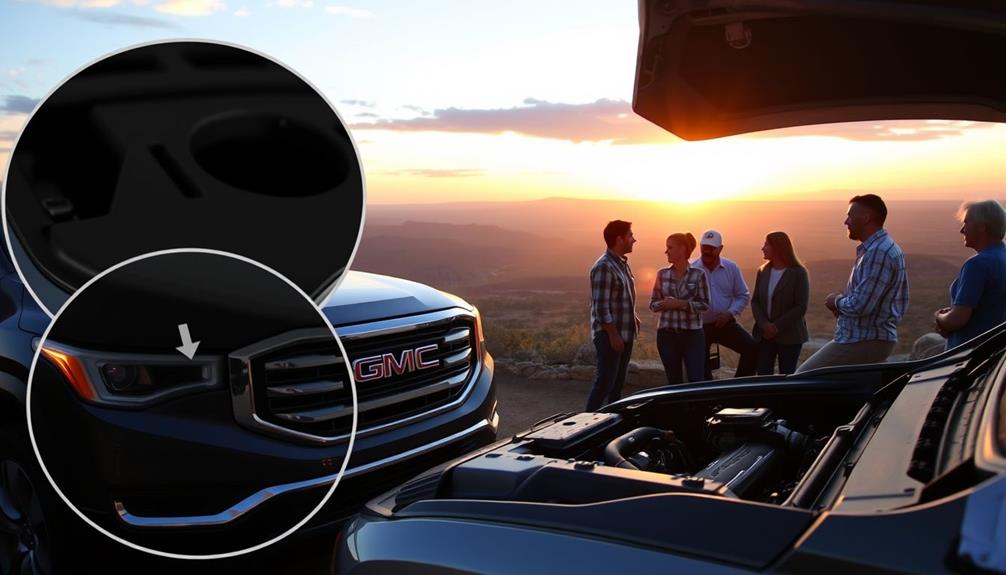
GMC Acadia owners have taken to community forums to share their experiences with the Intake Manifold Tuning (IMT) valve, revealing a pattern of recurring issues that impact engine performance and fuel efficiency.
Many drivers express frustration over the lack of warranty coverage for repairs, which can range from $250 to $500. With a growing emphasis on transparency in private equity, understanding the underlying factors that affect vehicle performance is essential.
You might find yourself in a similar situation, feeling misled about what's actually covered under the powertrain warranty.
Here are some common insights shared by fellow owners:
- Recurring Performance Issues: Many report engine power loss and decreased fuel efficiency due to IMT valve malfunctions.
- Costly Repairs: The financial burden of fixing the IMT valve often surprises owners, especially since these repairs typically aren't covered by warranty.
- Preventive Maintenance: Several Acadia enthusiasts recommend thorough inspection and cleaning of the IMT valve to avoid issues and enhance intake tuning.
With ongoing reliability concerns, some owners are even considering alternative brands.
Staying informed through community insights can help you make better decisions regarding your GMC Acadia's performance and maintenance.
Frequently Asked Questions
What Are the Symptoms of a Bad Intake Manifold Tuning Valve?
If your intake manifold tuning valve's bad, you might notice a Check Engine Light, increased fuel consumption, unusual engine noises, misfiring, or rough idling. These symptoms indicate it's affecting your engine's performance and efficiency.
What Does the Intake Manifold Tuning Valve Do?
The intake manifold tuning valve adjusts the runners' length to optimize airflow. It boosts your engine's power and torque, enhancing performance during acceleration while improving fuel efficiency and reducing emissions under various driving conditions.
How to Fix P2070 Code?
Think of your car like a puzzle; if one piece is out of place, it can't function right. To fix the P2070 code, inspect the IMT valve, clear codes, and check wiring thoroughly.
How to Fix P2078 Code?
To fix the P2078 code, inspect the IMT valve and wiring for damage. Clean any carbon buildup, and if it's stuck, replace the valve. Finally, clear the code with an OBD-II scanner.
Conclusion
To summarize, optimizing your GMC Acadia's intake manifold tuning valve can greatly enhance both power and efficiency. As the saying goes, "A stitch in time saves nine," addressing any issues early on can prevent more substantial problems down the road. Whether you're experiencing symptoms or just looking to boost performance, staying proactive with your vehicle's maintenance will guarantee a smoother, more enjoyable ride. Trust your instincts, and don't hesitate to seek help when needed! If you’re noticing a decrease in power or fuel efficiency, it could be a sign that the intake manifold tuning valve needs attention. Fixing power loss issues early on can prevent further damage to your vehicle’s engine and save you time and money in the long run. Don’t ignore any changes in your vehicle’s performance and address them promptly to ensure optimal functionality.
Sophia has a keen eye for automotive aesthetics and a passion for helping car owners express their personal style through their vehicles. With years of experience in designing custom body kits, spoilers, and carbon fiber parts, Sophia brings a wealth of knowledge to our appearance tuning section. Her articles and recommendations are perfect for anyone looking to make their car stand out on the road or at a show.
GMC tuning
GMC Sierra 2024 Tuning: Bringing Future Performance to Your Pickup
Get ready to unlock your GMC Sierra 2024’s full potential with innovative tuning options that promise enhanced performance—discover what’s possible today!

Tuning your 2024 GMC Sierra can greatly enhance your pickup's performance and fuel efficiency. With options like ECM modifications and custom tunes, you can tailor your vehicle's capabilities to fit your driving style and needs. Upgrading components, such as suspension and transmission tuning, optimizes torque management, leading to improved acceleration and drivability. You'll also find that modern tuning tools make the process easier, though costs typically range from $1,000 to $1,500. Interested in maximizing your Sierra's potential? There's plenty more to discover about the latest tuning trends and options for your truck. Looking to explore the world of tuning but not sure where to start? Consider researching “toyota tacoma tuning tips” to learn about the latest trends and recommendations for enhancing your truck’s performance. Additionally, consulting with a professional tuner can provide valuable insight into the best options for your specific vehicle and driving preferences. Whether you’re looking for increased power, better fuel efficiency, or improved towing capabilities, tuning your GMC Sierra can help you achieve your goals.
Key Takeaways
- Tuning devices like the InTune 3 GM E90/T93 Kit enhance the performance of the 2024 GMC Sierra models with tailored adjustments.
- ECM modifications can significantly improve engine output, but costs range from $1,000 to $1,500, plus additional fees for TCM access.
- Custom tunes optimize performance and fuel economy, particularly for heavy towing and off-road capabilities in the GMC Sierra.
- Limited tuning options exist for refreshed models from 2022.5 and above, making aftermarket solutions crucial for performance enhancements.
- Advanced features like the ProGrade Trailering System and improved torque management enhance towing and driving experiences in the 2024 Sierra.
Tuning Options and Tools
When it comes to tuning your GMC Sierra 2024, there are several effective options and tools at your disposal. One popular choice is the InTune 3 GM E90/T93 Release Kit, which, while primarily for 2019-2022 models, sets the stage for understanding the tuning options available.
Engine and transmission tunes can greatly enhance your vehicle's performance, and handheld tuners let you adjust various parameters in your control system with ease. Additionally, just as diversifying a retirement portfolio is essential in a volatile economy, exploring various tuning options can lead to a more balanced performance for your truck. For insights on investment strategies in precious metals, consider how they parallel optimizing vehicle performance through careful tuning choices.
For more advanced tuning, you might consider HP Tuners, which provides services for ECM modifications. However, be prepared for costs ranging from $1,000 to $1,500, along with additional fees for TCM releases and credits.
Keep in mind that tuning options are limited for refreshed models from 2022.5 and above, which means ECM modifications will be necessary, increasing both complexity and expense.
As you explore these tuning avenues, remember that many services partner with businesses selling forced induction kits, showcasing a growing trend in the aftermarket for GMC Sierra performance enhancements. Your journey to optimizing your pickup starts with understanding these tools and options.
Performance Outcomes

Tuning your GMC Sierra 2024 can lead to impressive performance outcomes that transform your driving experience. Whether you own a Crew Cab or the luxurious Sierra Denali Ultimate, performance tuning can enhance your truck's capabilities considerably.
Users have reported remarkable improvements in higher RPM ranges, especially when using 91 octane fuel. While low-end power gains might be limited, the benefits at higher speeds are undeniable. Additionally, it's crucial to approach tuning with caution, ensuring that you protect your savings by avoiding potential scams related to aftermarket parts and services.
By optimizing factory settings, tuning services can boost overall performance and fuel economy. However, results vary depending on your specific modifications and driving conditions. Custom tunes, made possible through module access, allow for tailored enhancements that can significantly improve acceleration and drivability.
While some aftermarket modifications may yield minor gains, substantial improvements often require more extensive upgrades, like supercharging. This is especially true for those seeking a truly exhilarating experience behind the wheel of their Sierra Denali Ultimate.
Historical Context of Tuning

Tuning options have come a long way, making it essential for you to understand their evolution.
Earlier models had straightforward modifications, while today's vehicles face more complex restrictions that impact performance standards.
Effective preparation maximizes outcomes, just as understanding these historical changes shapes your tuning choices and engine potential as you explore the GMC Sierra 2024.
Evolution of Tuning Options
Historically, tuning options for vehicles have undergone significant transformation, reflecting changing technology and regulatory landscapes. In the past, you enjoyed a wide range of straightforward modifications, largely unhindered by the complex ECM restrictions found in newer models. Early tuning practices, like high octane tunes, showcased the freedom to fine-tune performance with relative ease.
Now, the landscape has evolved. Canned tunes have made it simpler for you to enhance drivability in engines like the 5.3L, offering improvements without extensive customization, yet many enthusiasts feel nostalgic for the less restricted options of yesteryear.
| Tuning Era | Characteristics |
|---|---|
| Early Days | Simple modifications, fewer restrictions |
| Modern Era | Complex ECM, more investment needed |
| Current Trends | Canned tunes, advanced tech, nostalgia |
This shift reflects a mix of technological advances and regulatory pressures, leading to a market where performance modifications now require more investment and expertise. While you adapt to these changes, the desire for the simplicity of earlier tuning options remains strong among passionate enthusiasts.
Impact on Performance Standards
As vehicle performance standards have evolved, the impact of tuning on these benchmarks can't be overlooked. Historically, tuning has played an essential role in enhancing engine outputs, with advancements in technological innovations reshaping the strategies behind modifications.
You may recall how high-octane tunes for older engines allowed significant torque management adjustments, showcasing the potential of tuning to elevate performance.
Today, the landscape has shifted dramatically. With the introduction of ECM restrictions in models like the 2024 GMC Sierra, available modifications are more complex than ever. However, the push for improved drivability has led to the development of canned tunes for 5.3L engines, illustrating a continuing trend of optimizing performance through tailored solutions.
Consider these points about tuning's historical impact:
- Earlier models offered unrestricted tuning options that allowed for dramatic performance gains.
- Canned tunes reflect a balance between modern limitations and the desire for enhanced performance.
- Nostalgia for simpler modifications highlights the yearning for the past.
- Advances in tuning technology, like performance packages and custom tunes, cater to today's demand for more power.
Ultimately, while restrictions may exist, tuning remains an important factor in shaping contemporary performance standards.
Costs and Accessibility
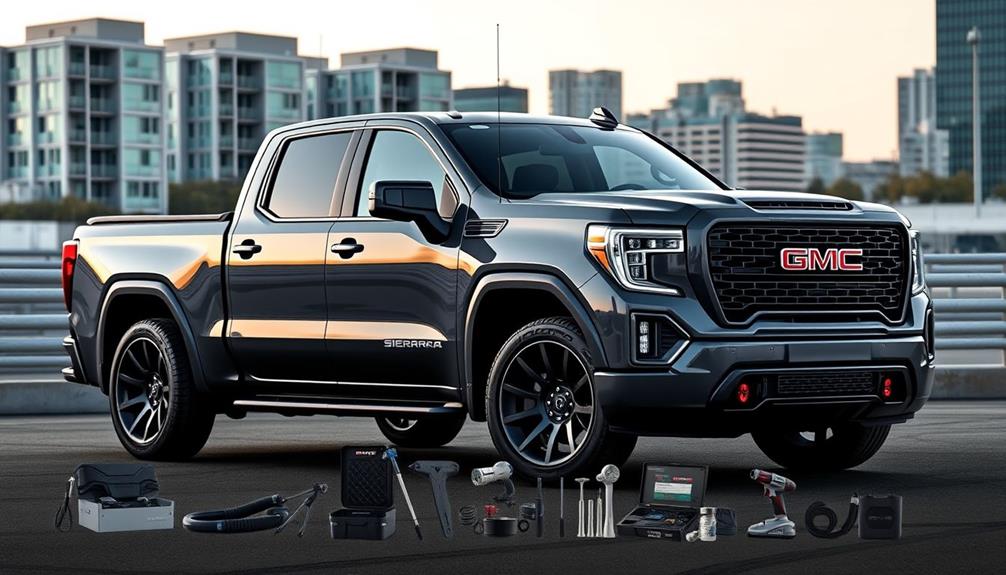
For those looking to enhance their 2024 GMC Sierra, understanding the costs associated with tuning is important. Tuning services typically range from $1,000 to $1,500 for ECM modifications.
If you're considering TCM access, you'll need to budget an additional $200 to $400. Each tuning session also requires eight credits from HP Tuners, which will set you back $50 per credit, further adding to your expenses.
It's also wise to assess your investment goals when considering these modifications, as the financial commitment can be significant.
Given the ECM restrictions on the refreshed models (20.5 and above), your tuning options may be limited, increasing both complexity and costs.
It's important to keep in mind that any tuning modifications you make could potentially void your GM warranty, which can be a significant concern for many enthusiasts.
Additionally, understanding the limitations of bolt-on modifications is essential. While they may offer some performance improvements, setting realistic expectations will help you avoid disappointment.
Transmission Tuning Insights

When you tune the transmission of your GMC Sierra 2024, you're optimizing torque management for better acceleration, especially during heavy towing or off-road adventures.
This process not only enhances performance but also improves the overall user experience by allowing you to navigate various driving conditions with ease.
With the option for custom tunes after unblocking the TCM, you can tailor the performance to match your driving style.
Plus, taking advantage of performance package benefits can greatly enhance both responsiveness and fuel efficiency.
Torque Management Optimization
Optimizing torque management through transmission tuning can markedly enhance your GMC Sierra 2024's performance. By reducing torque management settings, you can experience improved acceleration and overall driving dynamics.
This is especially important given the increased restrictions in newer models, which require a deeper understanding of the vehicle's ECM for effective tuning. Understanding the importance of software quality assurance in development helps guarantee that your tuning process is executed with precision and reliability.
Consider these benefits of torque management optimization:
- Enhanced responsiveness during acceleration
- Improved drivability in various conditions
- Better fuel economy with tailored settings
- Customized performance matching your driving style
Professional tuning services can release your truck's potential, translating to a more engaging driving experience.
By leveraging custom tunes post-module release, you can tailor transmission performance to your preferences, guaranteeing that your GMC Sierra 2024 meets your specific needs. This optimization not only provides a thrill behind the wheel but also maximizes efficiency.
With the right adjustments, you'll notice a significant difference in how your pickup performs on the road. So, embrace the benefits of torque management optimization and elevate your driving experience to new heights.
Custom Tune Possibilities
Custom tuning possibilities for your GMC Sierra 2024 are frequently overlooked but can deliver substantial improvements in performance. One of the most impactful options is custom transmission tuning. By reducing torque management, you'll achieve quicker throttle response and enhanced acceleration. Accessing the transmission control module (TCM) is essential for implementing these tunes, which may cost an additional $200-$400 on top of the tuning service fees.
Here's a quick look at some key aspects of custom transmission tuning:
| Aspect | Details |
|---|---|
| Cost of TCM Access | $200-$400 |
| Model Year Availability | Limited for 22.5+ models |
| User Feedback | Varies from noticeable to minimal |
Professional ECM tuning optimizes both performance and fuel economy, as factory tunes often don't fully utilize the vehicle's capabilities. Keep in mind that results can vary; some enthusiasts report significant gains, while others experience less impact. Investing in custom transmission tuning could be your ticket to accessing the true potential of your Sierra 2024.
Performance Package Benefits
Upgrading to a performance package for your GMC Sierra 2024 offers numerous benefits that enhance both driving experience and vehicle capability.
One of the key highlights is transmission tuning, which can greatly improve your truck's responsiveness. By reducing torque management, you'll notice enhanced acceleration that makes driving more enjoyable. Additionally, with advancements in AI technologies, tuning can be optimized further to meet specific driving conditions and preferences.
Here are some notable benefits of performance transmission tuning:
- Tailored Performance: Custom tunes can be developed after accessing the transmission module, aligning upgrades with your specific driving needs.
- Fuel Efficiency: Professional ECM tuning not only enhances performance but can also improve fuel economy, making it a smart choice for enthusiasts.
- Towing Power: If you use your Sierra for towing, transmission tuning can boost power delivery and overall performance under load, ensuring a smoother experience.
- Balanced Optimization: While stock tuning by GM is designed for performance and fuel economy, aftermarket tuning can push those improvements even further.
With these enhancements, you'll enjoy a more powerful, efficient, and responsive pickup that meets your demands on and off the road.
Embrace the future of performance with your GMC Sierra 2024!
Powertrain Enhancements

When it comes to powertrain enhancements, the 2024 GMC Sierra raises the bar with its formidable 6.6L V8 Duramax Turbo-Diesel engine, which is expertly paired with a 10-speed Allison transmission. This dynamic duo delivers an impressive 470 hp at 2800 rpm and a staggering 975 lb.-ft of torque at 1600 rpm, guaranteeing you tackle any task with ease.
One of the standout features is the 25% increase in low-end torque production compared to prior models, optimizing performance for heavy-duty activities. The new cylinder head design, complete with improved cooling jackets, enhances combustion efficiency, allowing for better overall engine function. Plus, the 10-speed transmission's closer gear steps guarantee sustained peak power delivery and improved acceleration, especially when towing or hauling heavy loads.
Here's a quick summary of the powertrain enhancements:
| Feature | Specification | Benefit |
|---|---|---|
| Engine | 6.6L V8 Duramax Turbo-Diesel | High power and torque |
| Transmission | 10-speed Allison | Improved acceleration |
| Towing Capacity (3500 HD) | 36,000 lbs | Robust towing capability |
With these enhancements, the 2024 GMC Sierra is built to perform.
Trailer Technology Integration

The 2024 GMC Sierra Heavy Duty takes towing to the next level with its advanced trailer technology integration.
You'll appreciate the ProGrade Trailering System, which offers up to 14 available camera views, providing enhanced visibility while you tow. This feature not only boosts your confidence but also guarantees safety during your towing adventures.
With the rising importance of cybersecurity measures, it's crucial to have systems that can protect your vehicle's technology while on the road.
Here's what you can expect with this impressive technology:
- Adaptive cruise control seamlessly integrates into the trailer assistance features, making your towing experience safer and more convenient.
- The Trailer Side Blind Zone Alert system monitors blind spots, ensuring you're aware of your surroundings while maneuvering.
- Standard Gross Combined Weight (GCW) alerts help you keep track of your towing capacity, preventing potential overloading.
- Advanced monitoring systems keep you informed about your trailer's status, enhancing your trailering confidence on the road.
With these innovations, the 2024 GMC Sierra Heavy Duty is designed to make towing not just easier but also smarter.
Embrace the future of trailering technology, and enjoy your journeys with peace of mind.
Frequently Asked Questions
How Can I Make My GMC Sierra Faster?
To make your GMC Sierra faster, consider upgrading to a handheld tuner for engine adjustments, using high octane fuel, and exploring performance packages that boost acceleration and overall driving experience. Patience may be key for future options.
What Are the Changes in the GMC Sierra HD in 2024?
In 2024, you'll notice significant changes in the GMC Sierra HD, including a powerful 6.6L V8 Duramax engine, enhanced towing capacity, improved low-end torque, and a redesigned exterior with upgraded luxury features.
What Is the Best Engine for the GMC Sierra 1500?
For serious power, you'll love the 6.2L V8, delivering 420 horsepower and 460 lb-ft of torque. If you're after efficiency, the 2.7L Turbocharged I4 balances performance with impressive fuel economy—perfect for everyday driving.
How Much Horsepower Does the 2024 GMC Sierra 3500HD Have?
The 2024 GMC Sierra 3500HD packs an impressive 470 horsepower at 2800 RPM. This powerful engine, combined with its robust design, guarantees you've got the performance you need for any heavy-duty task ahead.
Conclusion
In tuning your 2024 GMC Sierra, you're not just enhancing performance; you're embracing a revolutionary shift in pickup capabilities. While some might argue that tuning is merely a trend, the historical evolution of automotive technology proves otherwise. As you integrate advanced trailer tech and optimize your powertrain, you're not just increasing horsepower—you're redefining what it means to drive a pickup. So, don't underestimate the impact of tuning; it's a gateway to a smarter, more powerful future.
Sophia has a keen eye for automotive aesthetics and a passion for helping car owners express their personal style through their vehicles. With years of experience in designing custom body kits, spoilers, and carbon fiber parts, Sophia brings a wealth of knowledge to our appearance tuning section. Her articles and recommendations are perfect for anyone looking to make their car stand out on the road or at a show.
GMC tuning
2008 GMC Acadia Intake Manifold Tuning Valve Stuck Open: Fixing Power Loss and Efficiency Issues
How to address the power loss and efficiency issues caused by a stuck open intake manifold tuning valve in your 2008 GMC Acadia? Discover effective solutions inside!

If your 2008 GMC Acadia's Intake Manifold Tuning valve is stuck open, you're likely facing power loss and reduced fuel efficiency. Common symptoms include rough idling, sluggish acceleration, and increased fuel consumption. To fix this, start with a visual inspection of the valve and components for damages. Use an OBD-II scanner to check for the P2070 error code and perform necessary tests for electrical issues or vacuum leaks. Cleaning the valve may provide temporary relief, but replacing it with an OEM part guarantees better results. Stick around to discover more about reliable repair options and community insights. For a long-term solution, consider upgrading to an aftermarket intake manifold tuning valve that is designed for improved durability and performance. Additionally, regular maintenance of the intake system and engine components will help maintain optimal performance. Engaging with online communities and forums can also provide valuable insights and “enhancing performance tips” from fellow GMC Acadia owners who have faced similar issues.
Key Takeaways
- Inspect the Intake Manifold Tuning Valve for damage or obstructions that may prevent proper operation.
- Use an OBD-II scanner to confirm the P2070 code and monitor the IMT valve's live data.
- Conduct a vacuum leak test to identify any air leaks affecting the air-fuel mixture.
- Clean the IMT valve to remove carbon buildup, but be prepared for potential replacement for a permanent fix.
- Reset the ECM after repairs to clear diagnostic trouble codes and monitor for recurrence of issues.
Understanding the P2070 Code
Understanding the P2070 code is essential for diagnosing intake manifold issues in your GMC Acadia. This code indicates a malfunction with the Intake Manifold Tuning (IMT) valve, specifically that it's stuck open.
When the IMT valve is stuck, you may experience significant engine performance issues and decreased fuel efficiency. It's important to select the right repair strategy to address these issues effectively, similar to how one would choose appropriate cold medications for symptom relief.
You might notice symptoms like poor acceleration, rough idling, and increased fuel consumption, along with the check engine light illuminating on your dashboard. The P2070 code often arises from mechanical failures in the IMT valve, including binding or sticking, but it can also result from vacuum leaks or electrical issues affecting valve operation.
To properly troubleshoot the P2070 code, you'll need specialized tools like an OBD-II scanner to retrieve trouble codes and monitor the IMT valve's functionality through live data.
Repairing this issue typically involves cleaning or replacing the IMT valve and ensuring that all related components, such as wiring and vacuum hoses, are in good condition.
Addressing the P2070 code promptly can restore your vehicle's performance and improve fuel efficiency, ensuring a smoother driving experience.
Symptoms of IMT Valve Failure

When the Intake Manifold Tuning (IMT) valve fails, your GMC Acadia can exhibit several noticeable symptoms that signal trouble. A stuck open IMT valve disrupts proper air intake management, leading to significant engine performance issues. You might experience rough idling, reduced acceleration power, and increased fuel consumption as the air-fuel mixture ratio becomes unbalanced.
Here's a quick overview of the symptoms you may encounter:
| Symptom | Description | Potential Consequences |
|---|---|---|
| Check Engine Light | Illuminates due to IMT valve malfunction | Indicates DTC P2070 |
| Rough Idling | Engine may shake or vibrate at idle | Can lead to stalling |
| Decreased Acceleration Power | Sluggish response when pressing the gas | Impacts driving experience |
| Increased Fuel Consumption | More fuel used than usual | Higher operating costs |
| Unusual Engine Noises | Sounds or vibrations during operation | May indicate further engine damage |
Ignoring these symptoms can lead to further engine damage and increased emissions, making it essential to address any IMT valve issues promptly.
Diagnostic Procedures for P2070

Diagnosing the P2070 code, which signals a stuck open intake manifold tuning valve, requires a systematic approach to pinpoint the issue accurately. Follow these diagnostic procedures to effectively address the problem:
- Visual Inspection: Start with a thorough visual inspection of the IMT valve and surrounding components. Look for any signs of damage or obstructions that could be affecting valve operation, similar to how maintaining an air purifier involves checking for obstructions that could hinder performance air purifier maintenance dos and don'ts.
- OBD-II Scanner: Use an OBD-II scanner to retrieve the P2070 trouble code. Check live data to observe the tuning valve's operation and monitor key engine performance parameters.
- Electrical Function and Vacuum Leak Test: Perform voltage and ground tests at the IMT valve connectors to verify proper electrical function. Additionally, conduct a vacuum leak test to check for any air leaks that might be disrupting the air-fuel mixture.
If you find issues during these procedures, it's crucial to clean the intake manifold and throttle body to remove carbon buildup, which can impede valve movement.
After completing your diagnostics and any necessary repairs, conduct a road test to confirm that the P2070 code doesn't reappear.
Repair Options and Considerations

A thorough examination of the Intake Manifold Tuning Valve (IMTV) is vital to resolving issues in your GMC Acadia. Start with a careful inspection of the valve to make sure it isn't stuck and can move freely.
If you notice any carbon buildup, a thorough cleaning can often restore its functionality. Additionally, understanding the significance of credit health can help you manage potential repairs more effectively, as financial stability can influence your ability to address automotive issues.
However, if the valve is inoperable, you'll need to take into account replacement. You can choose between OEM and aftermarket parts, both offering compatibility and reliability.
Don't forget to inspect associated components like vacuum hoses and electrical connections for any damage or corrosion, as these can also affect the IMTV's performance.
After completing any repairs or replacements, it's imperative to reset the engine control module (ECM). This step clears diagnostic trouble codes and allows you to monitor for any recurring issues.
Community Experiences and Insights

Community experiences reveal a wealth of insights into GMC Acadia intake manifold issues, particularly regarding the IMTV. Many owners have faced significant power loss and poor acceleration linked to the P2070 code, which indicates a stuck open intake manifold tuning valve. Engaging with community forums can be incredibly helpful, as similar discussions on energy-efficient appliances illustrate the importance of effective maintenance.
Here are some common themes shared by users:
- Cleaning IMTV: While cleaning the intake manifold tuning valve can provide a temporary fix, most find that replacement is necessary for lasting improvement.
- OEM Parts: Many recommend using OEM parts for replacement to avoid compatibility issues. Aftermarket components have led to recurring problems for others.
- Fuel Efficiency Gains: Addressing the P2070 code often results in better fuel efficiency, with some reporting up to a 15% increase in mileage after repairs.
Owners emphasize the importance of thorough inspections and share valuable troubleshooting tips. If you're experiencing power loss or efficiency issues, diving into these community insights can guide you on the path to a reliable repair.
Don't hesitate to reach out for advice—you're not alone in this!
Frequently Asked Questions
What Are the Symptoms of a Bad Intake Manifold Tuning Valve?
If your intake manifold tuning valve's bad, you might notice power loss during acceleration, rough idling, unusual engine noises, increased fuel consumption, and even engine stalling or misfires. Keep an eye on those symptoms!
What Causes Intake Valve Stuck Open?
When it rains, it pours! Your intake valve might get stuck open due to carbon buildup, mechanical failures, or electrical issues. Vacuum leaks can also throw a wrench in the works, affecting performance.
What Does the Intake Manifold Tuning Valve Do?
The intake manifold tuning valve adjusts airflow to optimize engine performance at various RPMs. It enhances torque and power delivery during acceleration, ensuring efficient air-fuel mixtures for improved fuel efficiency and overall vehicle responsiveness.
How to Fix P2070 Code?
For fixing the frustrating P2070 problem, first, inspect the IMT valve's integrity, clean carbon clogs, and replace it if necessary. After repairs, reset the ECM and road test to guarantee everything's running right.
Conclusion
In summary, addressing the P2070 code and the stuck intake manifold tuning valve is essential for restoring your 2008 GMC Acadia's power and efficiency. For instance, one owner noticed a significant drop in acceleration and poor fuel economy. After diagnosing the issue, they replaced the faulty valve, resulting in a smoother ride and improved gas mileage. Don't ignore these symptoms; tackling them early can save you time and money in the long run.
Sophia has a keen eye for automotive aesthetics and a passion for helping car owners express their personal style through their vehicles. With years of experience in designing custom body kits, spoilers, and carbon fiber parts, Sophia brings a wealth of knowledge to our appearance tuning section. Her articles and recommendations are perfect for anyone looking to make their car stand out on the road or at a show.
-

 Tesla Tuning2 months ago
Tesla Tuning2 months agoTesla Cybertruck Sales: How Many Have Been Sold So Far?
-

 Tesla Tuning2 months ago
Tesla Tuning2 months agoTesla Battery Replacement Costs Revealed: How Much Will You Pay?
-

 Tesla Tuning2 months ago
Tesla Tuning2 months agoSupercharging Tesla: How Long Does It Really Take?
-

 Tesla Tuning1 month ago
Tesla Tuning1 month agoWhere Are Tesla Cars Made? Explore the Manufacturing Locations!
-

 Tesla Tuning3 months ago
Tesla Tuning3 months agoTesla Mileage: How Many Miles Can You Drive on a Full Charge?
-

 Tesla Tuning2 months ago
Tesla Tuning2 months agoHow Much Does It Cost to Lease a Tesla? Get the Full Breakdown!
-

 Tesla Tuning3 months ago
Tesla Tuning3 months agoTesla CarPlay: Does Tesla Have Apple Integration?
-

 Tesla Tuning3 months ago
Tesla Tuning3 months agoTesla Powerwall Cost Breakdown: How Much Will It Save You?



























